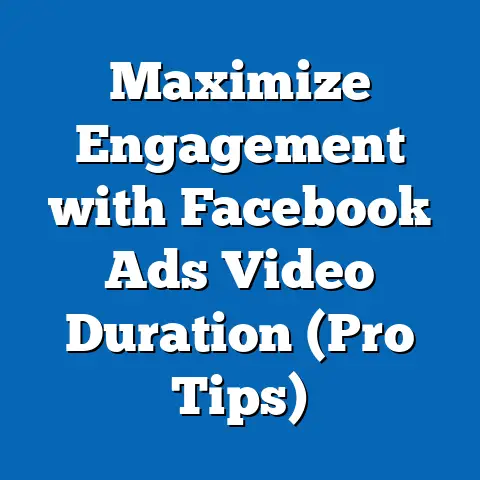Mastering Facebook: Hide Marketplace Ads (Expert Guide)
Imagine scrolling through your Facebook feed on a quiet Sunday morning, seeking a friend’s update or a lighthearted meme, only to be bombarded with an endless stream of Marketplace ads for used furniture, questionable electronics, and dubious deals. This was my reality a few months ago, as my once-personalized social space became a cluttered digital bazaar. Frustrated, I embarked on a mission to reclaim my feed, diving deep into the labyrinth of Facebook’s settings to hide these intrusive Marketplace ads.
This evolution was driven by broader technological and economic trends. The rise of the sharing economy, popularized by platforms like Airbnb and Uber, created a cultural acceptance of peer-to-peer transactions. Meanwhile, Facebook’s acquisition of vast user data enabled hyper-targeted advertising, making Marketplace a lucrative venture for the company, which reported over $26 billion in ad revenue in 2020 alone (Statista, 2021).
For many users, however, this commercialization has come at the cost of the platform’s original purpose. What was once a digital space for personal connection now often feels like a relentless marketplace, reflecting a tension between user experience and corporate profit motives. This historical shift provides critical context for understanding why so many users seek to hide Marketplace ads and reclaim control over their feeds.
Defining Characteristics of User Experiences Across Generations
The experience of navigating Facebook Marketplace ads is not uniform; it varies significantly across generational lines due to differences in technological fluency, social media usage patterns, and attitudes toward digital advertising. Let’s explore how different generations interact with this feature, drawing on both qualitative anecdotes and quantitative data.
Baby Boomers (Born 1946–1964):
Baby Boomers, who came of age before the internet era, often approach social media with a mix of curiosity and skepticism. Many use Facebook to stay connected with family or engage in community groups, but they are less likely to embrace its commercial aspects like Marketplace. According to a 2021 Pew Research Center study, only 27% of Boomers reported using social media for shopping purposes, compared to 45% of Millennials. For this generation, Marketplace ads can feel intrusive and irrelevant, prompting a desire to hide them to maintain a more personal feed.
Generation X (Born 1965–1980):
Gen Xers, often described as the “latchkey” generation, grew up during the advent of personal computing and are generally tech-savvy. They use Facebook for a mix of personal and professional purposes, and some engage with Marketplace for practical purchases like home goods or secondhand items. However, their pragmatic approach means they are less tolerant of clutter; a 2020 survey by eMarketer found that 62% of Gen X social media users expressed annoyance at irrelevant ads. This group often seeks ways to customize their digital experience, including hiding Marketplace content that doesn’t align with their needs.
Millennials (Born 1981–1996):
Millennials, the first generation to grow up with the internet, are digital natives who view social media as an integral part of life. They are more likely to use Marketplace for buying and selling, with 54% reporting occasional use in a 2022 Statista survey. However, their familiarity with digital platforms also makes them critical of over-commercialization. Many Millennials express frustration when ads disrupt their social experience, driving them to explore settings to hide or mute Marketplace content.
Generation Z (Born 1997–2012):
Gen Z, born into a world of smartphones and social media, has a highly curated approach to digital spaces. They value authenticity and are quick to reject content that feels inauthentic or overly commercial. A 2021 study by Morning Consult found that 73% of Gen Z users actively use ad blockers or privacy settings to control their online experience. For this generation, hiding Marketplace ads is often less about annoyance and more about asserting control over their digital environment.
These generational differences highlight the diversity of user experiences on Facebook. While annoyance with Marketplace ads is a common thread, the motivations and technical approaches to hiding them vary widely, shaped by each generation’s unique historical and cultural context.
Societal Implications of Digital Advertising Overload
The proliferation of Marketplace ads on Facebook is more than a personal inconvenience; it reflects broader societal trends and challenges in the digital age. Below, we explore the implications across multiple domains, including user psychology, economic behavior, and cultural shifts.
Psychological Impact and Digital Fatigue:
The constant influx of ads contributes to what researchers call “digital fatigue,” a state of mental exhaustion caused by information overload. A 2020 study published in the Journal of Consumer Psychology found that excessive online advertising can lead to decreased user engagement and increased stress levels. For younger generations like Gen Z and Millennials, who spend significant portions of their day online, this can exacerbate feelings of burnout, prompting them to seek tools and settings to limit ad exposure.
Economic Behavior and Consumer Trust:
While Marketplace ads are designed to drive local commerce, they also raise questions about consumer trust. Many users report encountering scams or low-quality listings, with a 2021 Better Business Bureau report noting a 25% increase in complaints related to online marketplace fraud. This erosion of trust can impact not only individual transactions but also the broader perception of peer-to-peer platforms, pushing users to demand more control over what they see.
Cultural Shifts in Digital Spaces:
The blending of social and commercial elements on platforms like Facebook reflects a cultural shift toward the commodification of personal interactions. As social media becomes a space for buying and selling, it challenges the notion of online platforms as purely social tools. This shift disproportionately affects younger users, who may feel that their personal spaces are being “sold” to advertisers, prompting pushback through actions like hiding ads or reducing platform usage altogether.
Workplace and Productivity Implications:
For professionals who use Facebook for networking or brand management, Marketplace ads can be a distraction. A 2019 survey by Hootsuite found that 48% of social media managers reported difficulty focusing due to irrelevant content in their feeds. This highlights a need for customizable user experiences, particularly for those who rely on social media as a professional tool.
These societal implications underscore the importance of user agency in digital spaces. As platforms prioritize revenue through features like Marketplace, users across generations are asserting their right to control their online experience—a trend with far-reaching consequences for the future of social media.
Step-by-Step Guide: How to Hide Marketplace Ads on Facebook
For those seeking to reclaim their Facebook feed from Marketplace ads, the platform offers several tools and settings to customize content. Below is a detailed, expert-level guide to hiding these ads, applicable across desktop and mobile interfaces as of 2023. Note that Facebook’s interface and policies may change, so users should check for updates regularly.
Step 1: Access Your Ad Preferences
– Log into your Facebook account via the app or website.
– On desktop, click the downward arrow in the top-right corner and select “Settings & Privacy,” then “Settings.” On mobile, tap the three-line menu in the bottom-right (iOS) or top-right (Android) corner and scroll to “Settings & Privacy.”
– Navigate to “Ads” or “Ad Preferences” to view the categories of ads shown to you.
Step 2: Adjust Ad Topics
– Within Ad Preferences, click on “Ad Topics” or “Advertisers and Businesses.”
– Look for topics related to “Marketplace,” “Shopping,” or specific product categories (e.g., “Home Goods”).
– Select “See Less” for each relevant topic to reduce the frequency of Marketplace-related ads. Note that this won’t eliminate ads entirely but can significantly decrease their visibility.
Step 3: Hide Specific Ads or Advertisers
– When a Marketplace ad appears in your feed, click the three dots in the top-right corner of the post.
– Choose “Hide Ad” to remove that specific ad from your feed. You can also select “Why Am I Seeing This Ad?” to understand the targeting criteria and adjust your preferences.
– If the ad is from a specific seller or business, select “Hide All Ads from This Advertiser” to block future content from that source.
Step 4: Disable Marketplace Notifications (Optional)
– If you receive notifications about Marketplace deals or listings, go to “Settings & Privacy” > “Settings” > “Notifications.”
– Scroll to “Marketplace” and toggle off notifications for updates, recommendations, or messages.
– This step won’t hide ads in your feed but will reduce Marketplace-related interruptions.
Step 5: Use Third-Party Tools (Advanced Option)
– For tech-savvy users, browser extensions like uBlock Origin or AdBlock can filter out Marketplace ads on desktop. Install the extension via your browser’s store and customize filters to target Facebook ads.
– Be aware that using third-party tools may violate Facebook’s terms of service, and functionality can vary with platform updates.
– Mobile users can explore ad-blocking apps, though effectiveness is limited due to app store restrictions.
Step 6: Provide Feedback to Facebook
– If Marketplace ads remain persistent, use the “Report a Problem” feature under “Settings & Privacy” to provide feedback directly to Facebook.
– Specify that you find Marketplace ads intrusive and request more control over feed content.
– While not guaranteed to result in immediate change, user feedback can influence future updates.
Troubleshooting Tips:
– If changes don’t take effect immediately, clear your browser or app cache to refresh settings.
– Remember that hiding ads is not a one-time fix; new advertisers or topics may require periodic adjustments.
– For persistent issues, consider reducing overall ad exposure by limiting data sharing in your privacy settings (e.g., under “Your Information”).
This guide empowers users to take control of their Facebook experience, addressing the annoyance of Marketplace ads with actionable steps. However, it’s worth noting that complete ad removal is unlikely due to Facebook’s business model, which relies heavily on advertising revenue.
Technological and Economic Factors Behind Marketplace Ads
The persistence of Marketplace ads is rooted in technological and economic imperatives that shape social media platforms. Understanding these factors provides insight into why hiding ads can feel like an uphill battle and highlights the broader dynamics at play.
Technological Drivers:
Facebook employs sophisticated algorithms to personalize content, including Marketplace ads, based on user behavior, location, and interests. Machine learning models analyze everything from search history to group memberships to predict what users might buy, ensuring ads are highly targeted. A 2022 report by the MIT Sloan School of Management noted that such personalization increases ad click-through rates by up to 30%, making it a cornerstone of platform revenue.
However, this same technology can overwhelm users when it prioritizes commercial content over social interactions. The algorithmic bias toward engagement often means that once a user interacts with Marketplace—even accidentally—they are flagged as a potential buyer, leading to a flood of similar ads. This technological loop explains why even hidden ads can reappear under new guises.
Economic Incentives:
Economically, Marketplace is a goldmine for Facebook, combining direct revenue from promoted listings with indirect benefits from increased user time on the platform. According to a 2021 financial analysis by Bloomberg, Marketplace contributes significantly to Facebook’s “Other” revenue category, which grew by 36% year-over-year. This economic model incentivizes the platform to push Marketplace content aggressively, even at the risk of user dissatisfaction.
For small businesses and individual sellers, Marketplace offers a low-cost way to reach local audiences, aligning with broader trends in e-commerce democratization. However, this economic benefit for sellers often comes at the expense of regular users, who bear the brunt of an ad-saturated feed. Balancing these competing interests remains a challenge for platforms like Facebook.
Cultural and Social Nuances Within User Responses
While the desire to hide Marketplace ads is widespread, cultural and social factors add layers of complexity to user responses. These nuances remind us that generational trends are not monolithic and that individual experiences vary widely.
Cultural Differences in Ad Perception:
Cultural attitudes toward advertising influence how users perceive Marketplace ads. In collectivist cultures, where community and local exchange are valued, users may be more tolerant of Marketplace content as a form of social commerce. Conversely, in individualistic cultures, where personal space is prioritized, ads are more likely to be seen as intrusive, as noted in a 2020 cross-cultural study by the University of Amsterdam.
Social Class and Access:
Socioeconomic status also plays a role. Users from lower-income brackets may engage with Marketplace as a cost-effective way to buy or sell goods, viewing ads as a necessary trade-off. In contrast, users with greater financial resources might prioritize a “clean” feed over potential deals, reflecting class-based differences in platform usage, as highlighted in a 2021 report by the Pew Research Center.
Gender and Behavioral Patterns:
Gender can influence interaction with Marketplace ads as well. Studies, such as a 2019 analysis by Nielsen, suggest that women are more likely to browse Marketplace for household items or clothing, while men may focus on electronics or tools. These behavioral patterns mean that ad targeting—and the subsequent need to hide ads—can vary by gender, adding another dimension to user experience.
These cultural and social nuances underscore the importance of avoiding broad generalizations when discussing generational responses to digital advertising. They also highlight the need for platforms to offer flexible, user-centric solutions that account for diverse needs and preferences.
Comparative Analysis: Marketplace Ads vs. Other Platform Advertising
To fully understand the impact of Marketplace ads, it’s useful to compare them with advertising strategies on other social media platforms. This analysis reveals both commonalities and unique challenges associated with Facebook’s approach.
Instagram (Owned by Meta):
Like Facebook, Instagram integrates shopping features through “Instagram Shops” and sponsored posts. However, its visual-first design means ads are often more seamless, blending into Stories or feeds as native content. A 2022 survey by Sprout Social found that 65% of Instagram users found shoppable posts less intrusive than Facebook Marketplace ads, suggesting that presentation matters in user perception.
Twitter (Now X):
Twitter’s advertising focuses on promoted tweets and trends, which are less localized than Marketplace ads. While users can mute or block specific advertisers, Twitter offers fewer granular controls compared to Facebook’s Ad Preferences. This lack of customization can frustrate users, though Twitter’s ads are generally seen as less disruptive due to the platform’s text-based, fast-paced nature.
TikTok:
TikTok’s “For You” algorithm heavily incorporates sponsored content and in-app shopping, often tied to viral trends. Unlike Marketplace ads, which focus on local transactions, TikTok ads are global and trend-driven, appealing especially to Gen Z. A 2021 study by Kantar found that 70% of TikTok users engage with branded content willingly, a stark contrast to the annoyance reported with Marketplace ads.
This comparison highlights that while all platforms grapple with balancing user experience and revenue, Facebook’s Marketplace ads stand out due to their hyper-local focus and integration into a historically social space. This unique positioning amplifies user frustration, driving the demand for tools to hide such content.
Forward-Looking Insights: The Future of Social Media and Advertising
As we look to the future, the tension between social media’s social roots and commercial ambitions is unlikely to resolve easily. Several trends and uncertainties will shape how platforms like Facebook manage features like Marketplace and how users respond.
Increased User Control and Privacy Regulations:
With growing concerns over data privacy, regulations like the EU’s General Data Protection Regulation (GDPR) and California’s Consumer Privacy Act (CCPA) are pushing platforms to offer more transparency and control over ad targeting. Future updates to Facebook may include more robust tools to hide or opt out of specific ad categories like Marketplace, though complete ad removal remains improbable due to revenue dependencies.
Rise of Ad-Free Alternatives:
The emergence of subscription-based or ad-free social platforms could challenge Facebook’s model. Platforms like Patreon or niche community apps offer ad-free experiences for a fee, appealing to users frustrated with commercial overload. If this trend gains traction, Facebook may need to rethink its reliance on intrusive advertising to retain users, particularly younger generations.
Generational Shifts in Platform Usage:
As Gen Z and future generations prioritize authenticity and curated digital spaces, platforms may face pressure to de-emphasize commercial features in favor of social connection. However, economic realities suggest that advertising will remain central, potentially leading to a bifurcated user base: those who tolerate ads for free access and those who pay for premium, ad-free experiences.
Technological Advancements in Personalization:
Advances in AI could enable more nuanced ad delivery, reducing the “spam” effect of Marketplace ads by better matching content to user intent. However, this also raises ethical questions about surveillance and data use, which could fuel further user pushback.
The future of social media advertising, including Marketplace ads, remains uncertain, shaped by technological innovation, regulatory landscapes, and evolving user expectations. What is clear, however, is that user agency will play a central role, with tools to hide or customize content becoming a key battleground for trust and engagement.
Conclusion: Reclaiming Digital Space in an Era of Commercialization
The journey to hide Facebook Marketplace ads, as explored in this guide, is more than a technical exercise; it reflects a deeper struggle to maintain personal space in an increasingly commercialized digital world. From the historical evolution of Facebook into a commerce-driven platform to the generational nuances of user experiences, the issue touches on psychological, economic, cultural, and technological dimensions of modern life.
By following the step-by-step guide provided, users can take practical steps to reduce the intrusion of Marketplace ads, asserting control over their feeds. Yet, the broader societal implications—ranging from digital fatigue to shifting cultural norms—suggest that this is only a partial solution to a systemic challenge. As social media platforms continue to evolve, the balance between user satisfaction and corporate profit will remain a contentious issue, with generational attitudes and regulatory developments shaping the outcome.
Looking ahead, the future of platforms like Facebook will likely involve greater user customization, driven by both technological advancements and societal demand for digital autonomy. While uncertainties abound, one thing is certain: users across generations will continue to seek ways to master their digital environments, ensuring that social media remains, at its core, a space for connection rather than commerce.





